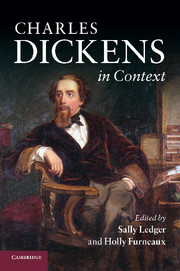Book contents
- Frontmatter
- Contents
- List of illustrations
- Notes on contributors
- Preface
- Notes on references
- PART I LIFE AND AFTERLIFE
- 1 The life of Dickens 1: before Ellen Ternan
- 2 The life of Dickens 2: after Ellen Ternan
- 3 Dickens's lives
- 4 Victorian stage adaptations and novel appropriations
- 5 Reviewing Dickens in the Victorian periodical press
- 6 The European context
- 7 Major twentieth-century critical responses
- 8 Modern stage adaptations
- 9 Modern screen adaptations
- 10 The heritage industry
- 11 Neo-Victorian Dickens
- PART II SOCIAL AND CULTURAL CONTEXTS
- Further reading
- Index
11 - Neo-Victorian Dickens
Published online by Cambridge University Press: 05 August 2012
- Frontmatter
- Contents
- List of illustrations
- Notes on contributors
- Preface
- Notes on references
- PART I LIFE AND AFTERLIFE
- 1 The life of Dickens 1: before Ellen Ternan
- 2 The life of Dickens 2: after Ellen Ternan
- 3 Dickens's lives
- 4 Victorian stage adaptations and novel appropriations
- 5 Reviewing Dickens in the Victorian periodical press
- 6 The European context
- 7 Major twentieth-century critical responses
- 8 Modern stage adaptations
- 9 Modern screen adaptations
- 10 The heritage industry
- 11 Neo-Victorian Dickens
- PART II SOCIAL AND CULTURAL CONTEXTS
- Further reading
- Index
Summary
The vogue for reimagining the nineteenth century, especially through its novels and novelists, depends on the continuing currency of Dickens and his work, for without his celebrity, one suspects that a good percentage of the cultural capital that keeps this ever-expanding enterprise afloat would rapidly depreciate. Sometimes Dickens seems to hover over the neo-Victorian like an avuncular but reticent deity; at others, he is all too intrusive; transformed into a quasifictional character, he stalks his virtual world and makes guest appearances in our own. Yet, as his contemporaries understood, ‘the Inimitable’ is one of the hardest of all Victorian writers to replicate. The orchestration of the dissonant registers within Dickens's fiction, some more appealing to twenty-first-century tastes than others, acts, like the multiple fonts and the watermark in a banknote, as a deterrent to full-scale literary imitation. And Dickens's unassailable status today – the ubiquitous presence of his work in multiple media – makes pastiche Dickens, as an end in itself, seem rather pointless when marketed alongside the readily available real thing.
Even with these drawbacks the project has attracted very gifted novelists, for whom it has represented a formal challenge. As a subgenre with considerable cultural ambitions, the neo-Victorian more generally came into its own in the 1970s with best-selling novels such as John Fowles's The French Lieutenant's Woman (1969) feeding off and contributing to the development of the postmodern novel.
- Type
- Chapter
- Information
- Charles Dickens in Context , pp. 81 - 88Publisher: Cambridge University PressPrint publication year: 2011
- 3
- Cited by



